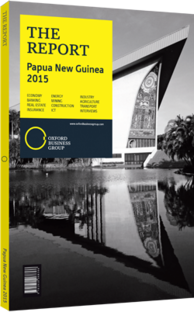Favourable conditions
Palm oil has long been a success story for Papua New Guinea’s agricultural sector, with large plantations providing the bulk of agricultural export revenues and serving as a crucial component of economic diversification efforts to balance out the heavily weighted extractive industry sectors. Established in the 1960s, the original Hoskins and Bialla (now Hargy Oil Palms) oil palm plantations were set up in New Britain according to the nucleus estate smallholder (NES) model.
The NES system was designed to be not only profitable but to also benefit local communities which were already largely dependent on agriculture as a means of subsistence. Under this system the small holder is responsible for cultivating and harvesting their own crops on their land, while nearby milling companies (the nucleus) are responsible for the collection, transportation, and processing of the fresh fruit bunches, along with their own supply. These local small holders participate in the system under two primary structures: the Land Settlement Scheme (LSS) and Village Oil Palm (VOP). The LSS scheme was used in the older plantations which alienated customary land under 99-year leases, some of which were then farmed by settlers from other areas of the country and are now becoming stressed as multiple generations from the original farmers are now working the same plots. The LSS scheme was gradually replaced by the VOP, which is generally less productive but allows for the development of workers’ own customary land. The Clan Land Usage Agreement (CLUA) has more recently been developed for customary landowners and migrant smallholders growing oil palm on customary land which allows for the purchase of usage rights rather than land title. As of December 2014 there were a total of 21,101 smallholder blocks established across the country composed of 14,904 VOP, 5231 LSS and 966 CLUA and independent estates according to data from the PNG Palm Oil Council (POC).
Major Producers
There are currently two major palm oil producers operating in the country: New Britain Palm Oil (NBPOL), and Hargy Oil Palms. Industry leader NBPOL has acquired a number of competing plantations over the years and currently accounts for the vast majority of output in the sector including five of the six primary growing areas.
The company controls a total 64,427 ha of palm oil at the West New Britain plantation area (43.5% of the total palm oil area) around Hoskins which is split between 36,985 ha of plantation acreage and 27,442 ha of smallholder and other out growers. The other four areas NBPOL works are Higaturu (22,822 ha) in Popondetta, Milne Bay Estates (12,907 ha) at Milne Bay, Poliamba (8352 ha) in New Ireland and Ramu Agri Industries (12,918 ha) at Ramu.
The Bialla Oil Palm Project, managed by Hargy Oil Palms was established in 1969 and has a total planted area in production of 26,843 ha (13,002 ha plantation, 13,841 ha smallholders and 1948 ha other growers). A third competitor – Malaysian agribusiness giant RH, which is already a major player in PNG’s forestry sector– is developing a 42,000-ha oil palm plantation in East New Britain province. The Sigite Mukus Integrated Rural Development Project will include 31,000 ha dedicated to oil palm as well as three oil mills requiring an investment of PGK600m ($227m).
Weather Conditions
Buoyed by favourable weather conditions and an expansion of the plantation area, the production of palm oil fresh fruit bunches increased 10.6% in 2014 to 2.63m tonnes from 2.34m tonnes the previous year. Plantation harvests accounted for 1.6m tonnes in 2014 (up 12.1% over the previous year) with the remaining 776,402 tonnes harvested by smallholders and other out growers (up 7.3% over 2013 levels). Palm oil companies exported 514,757 tonnes of crude palm oil (CPO) in 2014, easily outpacing 487,200 tonnes shipped the previous year. Shipped exclusively to the EU, CPO and other palmderived exports remain the largest source of revenue for the agriculture sector in PNG, netting PGK1.5bn ($567.6m) in 2014 and PGK1.2bn ($454.1m) in 2013.
You have reached the limit of premium articles you can view for free.
Choose from the options below to purchase print or digital editions of our Reports. You can also purchase a website subscription giving you unlimited access to all of our Reports online for 12 months.
If you have already purchased this Report or have a website subscription, please login to continue.

